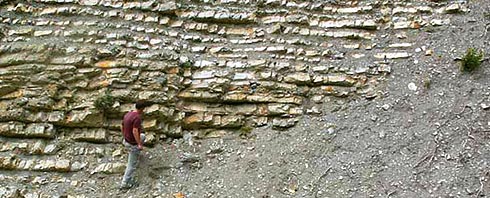
The objective of the paleomagnetic testing is to determine directions of the ancient geomagnetic fields recorded in rocks and to track their changes with time. Present-day magnetization of rocks results from combination of magnetic vectors of different ages that can be identified by demagnetization, using the variable magnetic field or altering the temperature. Valuable information can be provided not only by primary but also secondary components of magnetization. Paleomagnetism is one of the geophysical specialties that are very closely related to geology, and its numerous applications are used in stratigraphy, tectonics, and paleoenvironmental studies (especially magnetic susceptibility studies).
- Paleogeographic reconstructions of the position of continents and smaller tectonic units in various Phanerozoic epochs
- Magnetostratigraphic schemes and correlations (based on changes in polarity) of rock units devoid of index fossils
- Reconstruction of paleoenvironmental conditions (mainly paleoclimatic) based on variability of selected petromagnetic parameters
- Dating of diagenetic events based on secondary magnetization components
- Determination of the orientation of drill cores, based on the viscous remanent magnetization (VRM)
- Determination of magnetic susceptibility and remanent magnetization of rocks to interpret magnetic maps
- Assessment of anisotropy of magnetic properties of rocks and its tectonic interpretation
The following investigations can be undertaken in our paleomagnetic laboratory:
- assessment of residual magnetization directions and intensities, which are present in all types of rocks
- measurements of magnetic susceptibility and its directional properties (anisotropy of magnetic susceptibility – AMS),
- determination of magnetic properties of rocks: identification of mineral carriers and magnetic susceptibility carriers.
EQUIPMENT AND SOFTWARE
- JR-6 i JR-5 – spinner magnetometers, produced by AGICO, Brno (Czech Republic)
- MMTD1 – Thermal Demagnetizer for rock sample analysis, from Aughton Magnetic Measurements Ltd (UK)
- KLY-2 – Kappabridge for determination of magnetic susceptibility, produced by AGICO, Brno (Czech Republic)
- MMLFC – Helmholz cage for eliminating external factors of magnetic field, produced by Magnetic Measurements Aughton (UK)
- Pulsatory Magnetiser produced by Magnetic Measurements Aughton (UK)
- pARM Molspin – equipment used for demagnetization of rock samples using the variable magnetic field, with a special device for acquisition of non-hysteresis remanent magnetization, produced by Molspin (UK)
- Bartington Susceptibility Meter – for measuring magnetic susceptibility of soils and rocks in both laboratory and field conditions, equipped with the MS2 meter and the MS2B, MS2D, MS2W sensors
- MS2 meter – a device with effective resolution of 2 x 10–6 SI (2 x 10–7 CGS) and a 4-digit display, SI or CGS unit switch
- MS2B – a laboratory sensor for measuring both mass and volumetric magnetic susceptibilities. Measurements are carried out on cubes or cores with diameters up to 25,4 mm or on samples of 10 ml or 20 ml volume. Manual feeder facilitates the insertion of the sample into the sensor cavity and ensures that samples are perfectly centered. The sensor allows also assessing anisotropy of magnetic susceptibility
- MS2D – in situ sensor, a loop of 185 mm diameter used for surface measurements. Depth range: 100 mm
- MS2W – a laboratory sensor, integral part of the Susceptibility/Temperature System, used for thermal laboratory measurements of magnetic susceptibility on 2.5 ml samples over the temperature range of -200°C to +850ºC
- GEOLABSOFT software – collects data and plots a graph of susceptibility versus temperature
- SM-30 – magnetic susceptibility meter to measure susceptibility without collecting samples, directly at the surface of an exposure or on a drill core
- Drill MMPRD+ – produced by Magnetic Measurements, a portable drill set, weighing 5.4 kg, for drilling 20–32 mm cores, with a 15.9 cc motor, 2 speed gearbox and water-lubricated drill bits
- RemaSoft, PALMAG – software for analysis of components of magnetization
- GMAP – software for paleogeographical reconstructions
- ANISO software package – to undertake analyses of the magnetic susceptibility anisotropy of rocks














 PGI-NRI offer
PGI-NRI offer Mineral resources of Poland
Mineral resources of Poland  Oil and Gas in Poland
Oil and Gas in Poland 




 Subscribe to RSS Feed
Subscribe to RSS Feed